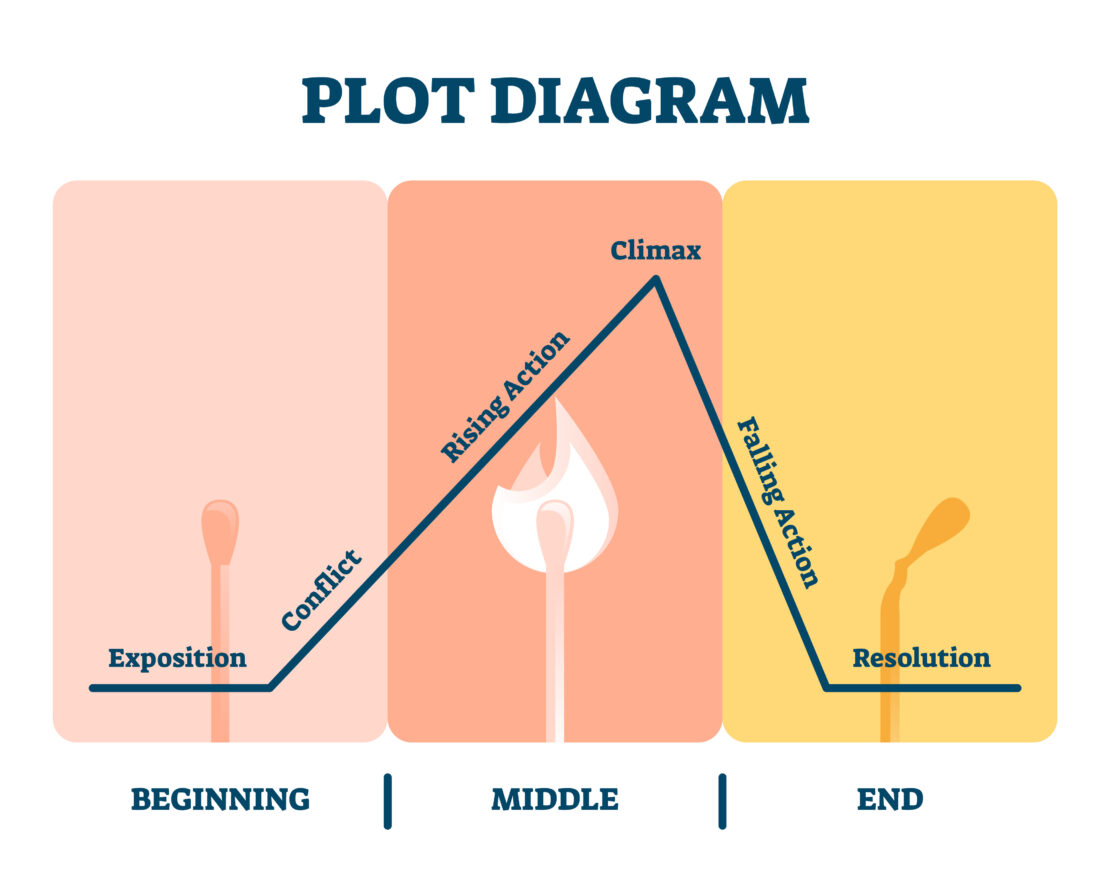The Tale You’re Telling: A Novel Idea for Website Content
Writing web content typically consists of communicating information with attempts at persuasion using keywords, buzzwords, and words the client likes. They’re dull and hyper-similar across the search results page, almost like following proclamations from some mandatory manual. Perhaps there is a Dan Brown novel in here somewhere.
Unlike Brown’s novels, people don’t want to read websites or company blogs. They tend to scan or read it quickly to get the information they’re after. That want is the problem.
What do people want to read? Stories.

It’s Not the News—Shake Up the Expository
Writing website content tends to involve fluffing up the client’s services and products with persuasive facts, delivered in a professional tone that successfully argues why this company or that solves this problem or another. It isn’t very engaging. Sure, some professional spaces require those elements; a law office or a healthcare provider, for example. Even then, content shouldn’t be delivered in a drab fashion.
“What’s the problem if the content does its job? People don’t go to a website to be entertained, after all.”
Sure, but why shouldn’t they be? It’s easier for people to remember something or agree with it if they like it. Not to mention that if people don’t want to read your website to learn about your product or service, they won’t. Doesn’t matter if it answers the query.
Do you know what people want to read? A good story.
You wouldn’t expect fiction writing techniques to carry over into web pages, but the methods used to write a good tale translate.
Theme: Where Are You Taking the Reader and Does It Make Sense?
Theme unites all the other elements in fiction—the why to where the characters are going and the purpose for what is happening.
So, why is your content going on the web page?
“To drive customer conversion and improve SEO rankings” doesn’t cut it, I’m afraid. That is similar to saying that the purpose of every book ever written is to make a profit.
Harry Potter isn’t about the adventure of an orphan wizard; it’s about the power of love, courage, and friendship. That is the message/theme of those books. So, what is the overall message that ties your content together?
Outside of unifying the content, the theme is a good guidepost for a writer. If you understand why you’re writing, then it’s easier to communicate the message to the reader. The theme is a cornerstone that avoids a disjointed feeling throughout the copy and improves the brand consistency, no matter the page topic. For example, is selling farm fresh food just about having the best food or online grocery store, or is it about creating a “grow-local” lifestyle and supporting sustainability? The latter is likely your theme.
The theme informs the potential customer of why they should shop with you versus a competitor; claiming “better or best” isn’t enough—everyone else is already doing that.
A Tale Worth Telling: Story Structure
Most of us are familiar with the basic narrative structure, but let’s look at how it could apply to web content:
- Set-up (Who is the company?)
- Conflict (What problem are they solving?)
- Climax (The stakes/consequences of the issue going unsolved)
- Resolution (The company solved the problem with their product or service)
This structure is standard in all fiction, from fairy tales to action flicks. Why is it so prevalent? Because it’s part of our collective history, and we’re literally wired for it.
Before writers were a thing, oral storytelling shared how to survive hunts, teach social rules, and navigate the winter. We learned from a character’s conflict and imitated the lesson shared in the resolution. Now, we crave to know how a conflict is resolved—hence, narrative structure.
If the narrative structure is used in copy, the result is no different. Readers can’t resist finding out the end and how the conflict is resolved. It immediately grabs their attention and transforms the web page into a stimulating read, making it more memorable.
Besides hooking the potential customer into a tale of the client’s service decimating their challenges or problems, you’re highlighting the company’s abilities in a natural and unforced way.
The Page Plot: Conflict and Tension
For content writing, this is best translated as “identifying pain points.” Pretty obvious for web page copy, but it deserves to be repeated anyway.
You should be discussing the conflict your potential customer has and driving home the implications of their problem, such as the costs, the time wasted, or how inefficient something is. Like the hero in a story, you want to dance on this tension and empathize with them. Don’t rush to the resolution without identifying the conflict (pain points) and building the tension (implications if they don’t solve the pain point) before introducing your business as the resolution (solution).
Take your reader on a journey to resolution with your service or product as the hero’s means at the end.
Compelling Characters: The Service and Company Aren’t Flat, Folks
A compelling and realistic character can make or break a story. Ever read a tale where the character was simple, not a lot of depth to them, just perfect in every way: a.k.a. Mary or Gary Sue? They ruin otherwise solid stories.
When writing copy, remember that your business is the main character. And, like all main characters, you need depth. If you think that your company doesn’t have a personality or identity, think again; what is branding if not defining just that?
While some characters are made more realistic because of their flaws, that doesn’t necessarily have to be your tactic. For example, a medical practice can be compassionate and empathetic, and an auto shop can be passionate about automotive engines and vintage cars. They aren’t just experts who do a stellar job in the field; they have interests and cares.
For example, instead of writing a doctor’s office as “In a calm clinic staffed by premiere medical professionals, we are devoted to the health of our patients while providing empathetic care.” You could say:
“We serve the health of the community where we live and understand anxieties around visiting a doctor’s office. After all, we’ve had medical appointments, too. Instead of a clinical distance, we remember how it feels to be on your side of the visit and use our professional expertise alongside empathy.”
You could also make it more personal:
“Dr. Doe grew up with anxiety around doctors and uses that memory to fuel how she communicates with her patients. This isn’t just ensuring the patient is OK or dealing with an illness, this is caring for a neighbor“
The latter two examples offer a personality and frame the business as a person instead of an entity that simply provides a service.
What’s important here is to present your business as a complete character with personality and goals, and to avoid cliches like the plague. If there is something about your company that doesn’t seem stereotypical, like product designers who have a sense of humor about themselves, integrate that into the content.
Having a memorable character means you’ll be remembered, and that’s good for business.
What’s Your Novel Idea?
Your approach to content doesn’t have to be stiff writing by numbers; it can be a creative expression of what the business offers. Fiction techniques aren’t only engaging for the reader but the writer, too. These methods will help you stand out and provide a clearer vision while writing with a sense of musicality that enchants your potential customers and convinces them to convert.
These out-of-the-box approaches to marketing and content are part of how Momentum separates ourselves from other agencies. Learn more tips and tools from other in-house experts by exploring our blog.
